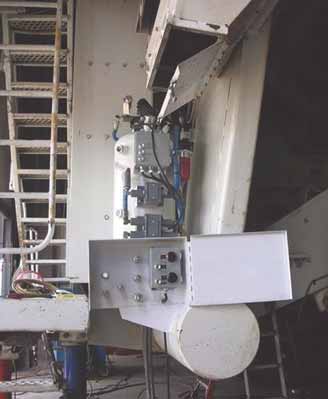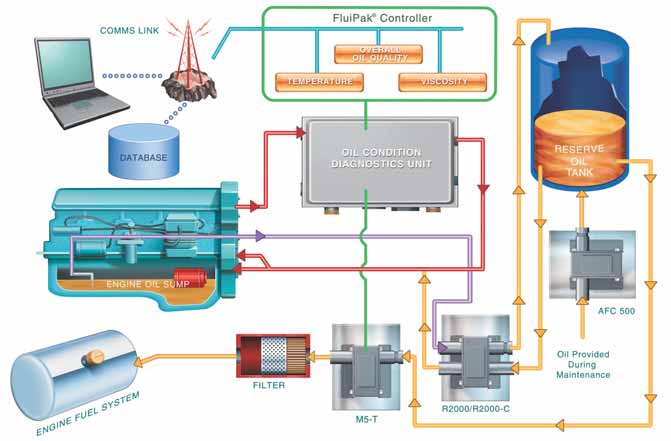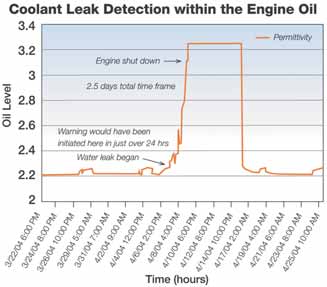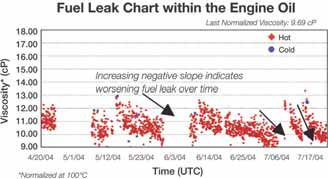
The 30-gallon reserve tank for the FluiPak system is mounted on the
front of the haul truck. Operators charge the system, which provides
an oil-leveling reservoir.
New System Enables Fleets to Tailor Maintenance Programs
Engine oil diagnostic system provides oil quality analysis in real time
and alleviates disposal costs
By Steve Fiscor, Editor-in-Chief

Now maintenance planners have two new tools available to them—FluiPak and FluiPak Lite—that provide insight into what’s happening with oil in the crankcase in real time. The Lubrizol Corporation developed both systems to pull engine oils and sample them continuously. For more than 75 years, Lubrizol has tested and developed lubricants that provide performance within industrial and transportation applications. In fact, Lubrizol, which has headquarters in Wickliffe, Ohio, USA has been instrumental in setting many of the specifications that the oil industry accepts as standards today.
What these onboard diagnostic systems provide the mines is real-time notification of oil quality, early contamination detection, healthier oil, increased operating time, and prolonged engine component life. While the system is not meant to replace drain analyses, the FluiPak system can be used to optimize drain intervals and reduce waste oil disposal costs. Filling the void between drain intervals, it enables maintenance managers to customize maintenance schedules.
Fluid Diagnostics
FluiPak has been on the market for a while. FluiPak Lite is relatively
new. “They are essentially the same technology,” said Ron
Dunfee, technical sales manager, Lubrizol. “FluiPak Lite is simply
a cut-down version of FluiPak.”
The FluiPak system has three main components: a control box, a sensor box, and a reserve system. The control box, or the brains of the operation, is where the data acquisition and control systems are housed. This is where the indicator lights and the connections to Ethernet cables or radio communications are located. The control box is typically placed either in the cab or just behind it.
The sensor box is usually mounted on the frame rail close to the engine. It needs to be close to the engine because the system is tapping into the high-pressure oil lines coming off the engine. “We typically tie into the high-pressure side of the oil system. That way we have no need for external booster pumps to pull oil off the engine’s lubrication system,” said Dunfee.
The sensor box has a rotational viscometer and a permittivity sensor. Permittivity relates to a material’s ability to transmit (or permit) an electric field. Lubrizol has studied permittivity extensively and developed an algorithm that modeled the degradation of oil. “As the oil properties change, the signal properties change,” said Dunfee. “Characteristics within the oil, such as contaminants, will have an impact on that electrical impulse. Lubrizol has a tremendous amount of knowledge about oil chemistry, and we understand how the chemistry in oils degrades over time. What we’re talking about primarily with permittivity is soot. Soot is a key indicator of oil degradation. As soot increases, permittivity increases.”
The reserve system provides oil leveling and ties into a reburn circuit. Normally, the reserve system is mounted vertically on the front bumper; some mines place them horizontally on the deck plate. Mining class haul trucks typically use a 30-gallon tank in either a horizontal or vertical configuration. “When oil quality hits a certain threshold, it will trigger a reburn pump that will take condemned oil from the reserve system and burn it through the fuel system,” Dunfee said. “It puts it into the fuel tank, and the condemned oil is burned at a maximum rate at 6 gallons per day. That’s the maximum rate for a system that runs 24:7.”
The FluiPak Lite essentially takes the control box and sensor box and molds them into one unit. The only component of the FluiPak reserve system that continued with the FluiPak Lite system is the M5 reburn pump. “The end-user gives up the oil-leveling aspect of the system,” said Dunfee. “On a dozer, for example, there is not as much real estate to work with and much higher vibration levels—track vs. rubber tires. The end-users are topping these off every 12 hours anyway, so they are willing to give up the reserve tank. What they really want is the diagnostics and oil quality improvement, which can help them with contaminant protection and being able to reburn engine oil.” FluiPak Lite is targeted for dozers, graders, and other support equipment.
How the System Works
The sensor box pulls oil off the high pressure side of the engine.
The oil passes through a manifold to measure the permittivity,
engine oil temperature and viscosity, and then returns to the
engine sump—a continuous loop. When the engine is running,
the system is running. It’s constantly monitoring oil temperature,
overall quality and the viscosity, and sending input up to the
controller. From the control box, a signal is sent to the end-user.
Lubrizol’s FluiPak produces a generic signal that can be read
many ways: laptop, data cards, or by remote radio frequency
(RF) signals.
The reserve system pulls oil out of the engine at a 10 gallon per hour rate and puts it into the 30-gallon reserve tank. The oil leveling system relies on a dip tube that’s set at the geometric center of the engine oil sump. It is set just above the low oil level limit of the engine, the optimum level recommended by the OEM. Once the dip tube senses air, it triggers stage two, where the reserve system switches from removing oil out of the engine to transferring oil from the reserve tank back into the crank case at 4 gallons per hour. The system is continuously maintaining the oil level up or down as required. For example, when a vehicle is going up or down a grade, the system automatically compensates to maintain the proper oil level in the engine sump. It does this very fast, constantly adjusting.

“Operators no longer charge the engine. They charge the FluiPak system’s reserve tank,” said Dunfee. “Typically, they would have a line hooked to a utility plate with quick disconnects for the system. The maintenance technicians would walk up, quick connect in, hit the AFC 500 pump, and fill the reserve tank. It’s got an auto-shutoff float system in it.”
The oil quality threshold is something that can be tailored to each mine. “If a mine wants to run robustly and maximize engine life, they can set a low threshold that runs in reburn more often,” Dunfee said. “Or, they can conserve oil and run high.”
The FluiPak Lite system operates in the same fashion without the reserve tank and the oil leveling mechanism. “The FluiPak Lite system pulls oil out of the engine oil sump as prescribed by the controller only when it’s running in a condemned situation and cannot run the oil level low due to the dip-tube location within the sump,” said Dunfee. “Otherwise, the pump is off and the system is running, giving the mine live data.”
Real-Time Sensing
Several benefits to the system are obvious—oil optimization,
maintenance scheduling, reduced oil disposal costs, etc.—while
others, such as early failure detection, are more intuitive.
“Lubrizol is not telling mine operators that they can immediately
extend the oil change interval X number of hours,” Dunfee
said. “Duty cycles differ depending on site-specific conditions.
We will work hand-in-hand with maintenance to determine the
fleet’s needs. Nor is the system designed to eliminate drain
analysis. That’s a critical tool for preventive maintenance.
FluiPak fills the blind spot between oil change intervals and
helps the fleet manager better understand where they can go
safely.” If engine oil remains clean and healthy, then so will the
engine components.

Fuel dilution in both older and newer designs is common. It can happen from poor-injection systems (plugged injectors, dribbling injectors, etc.). These systems are timed to inject precisely and to run at a correct air-fuel ratio. If they deviate from that, it creates problems. It could result from improper sealing of the combustion chamber where bad piston rings allow blow by. Most mine operators discover fuel dilution during the drain analysis. “There’s a big void between oil-change intervals,” Dunfee said. “When oil is fuel diluted, its viscosity is reduced. The FluiPak system will detect that immediately. That doesn’t mean that the mine operator has to pull that truck from the fleet immediately, but when they change drivers, they could take an oil sample and send it to the lab right away for further evaluation and do their own investigation to determine how the fuel is getting into the engine oil.”
Coolant contamination can signal a fairly minor problem or something major. If it’s not caught quickly, it could lead to hydrostatic lock or complete engine failure. This is an area, Dunfee explained, that clearly demonstrates the importance of having real-time sensing. “If a vehicle has a small leak, water will build in the crank case as the vehicle sits idle,” Dunfee said. “As soon as it reaches operating temperature, the engine will burn off the water. If the maintenance technicians are sampling a hot engine at an oil change, they might not catch it. If a sensor is active the moment the engine starts, they will see a spike in water and then see it drop off. They know they have seepage that has burned off.”
The FluiPak system is equipped for onboard communications. If the mine does not use RF uplinks, the next best thing is CompactFlash cards. Basically, the maintenance technician pops an empty card in and out, takes it to a reader, and downloads the information to a laptop or a database server. The technician could tie in directly with a laptop, but most mines would rather swap the cards and use the laptop in a clean office environment. The system has Ethernet and serial communications. “We are working with Modular Mining to fine tune that communication link,” said Dunfee. “Modular Mining will be used as a conduit to get the information to the server.”
Costs and Payback
Currently, Lubrizol has more than 100 units installed in coal operations.
The company plans to place new units in iron ore operations
in both extremely hot and cold environments. FluiPak Lite,
according to Dunfee, is in the infant stages of commercialization.
The mines would obviously save money by safely extending engine oil life. Each engine would also save money on the small amount of fuel that’s displaced by the condemned oil reburn. With the FluiPak system, the regen, on average, is active about 66% of the time. “There is also a potential fuel savings from running cleaner oil,” Dunfee said. “There is lab data that says that’s true.”

Using figures such as $250/h for engine uptime and $3,000 for doubling the oil change interval, one mine operator using the FluiPak system has calculated an annual savings rate on one truck to be as much as $34,000. If a mine were able to achieve that level of cost saving, according to Dunfee, the system would have a payback of less than one year.
Installation times vary by application, and Lubrizol’s goal is to get it done in one 12-hour period. “Mines have different protocols,” Dunfee said. “As an example, they want to see utility access on the right side vs. left to maintain consistency among the truck fleet. Typically, our distributor will have a two-man team who will work with the local mechanic/welder onsite to get the job done properly and efficiently.”

What excites Dunfee most about the FluiPak system is working with the mines. Lubrizol’s core business is centered on chemistry, and its customers traditionally are the major oil companies. “We were typically one level removed from the end-user,” Dunfee said. “To have a product that brings us closer to the end-user and to work closer and hear what they are seeing in real life is exciting. This is information that we can share with and benefit from along with our oil company customers.”
Real-time monitoring reveals the system’s potential. In addition to lowering the amount of waste product, optimizing the oil change interval, and providing a good return on investment, Lubrizol sees the FluiPak system as a way to improve the overall health of the engine through improved oil quality and early contaminant detection.